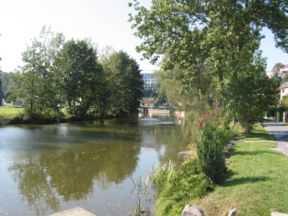German Thaya
| German Thaya | |
|---|---|
 German Thaya in Waidhofen an der Thaya | |
| Origin | near Schweiggers, Lower Austria |
| Mouth | Raabs an der Thaya, Lower Austria 48°50′52″N 15°29′25″E / 48.84778°N 15.49028°ECoordinates: 48°50′52″N 15°29′25″E / 48.84778°N 15.49028°E |
| Basin countries | Austria |
| Length | 75.8 km (47.1 mi) |
| Source elevation | 657.5 m (2,157 ft) |
| Mouth elevation | 410 m (1,350 ft) |
| Avg. discharge | 4.4 m3/s (160 cu ft/s) at mouth |
| Basin area | 770 km2 (300 sq mi) |
The German Thaya or Austrian Thaya (German: Deutsche Thaya, Czech: Rakouská Dyje) is a river in Lower Austria.
The river originates southwest of Schweiggers at an altitude of 657.5 meters. First, it flows in north-easterly direction to the village of Vitis, where it is joined by the left tributary Jaudlingbach. It flows further eastward to Schwarzenau and gradually turns to the north, zig-zagging through Waidhofen, Thaya, and Dobersberg. Then it turns to the east and southeast, flowing through Karlstein and Raabs an der Thaya, where it joins the Moravian Thaya.
From here the unified Thaya flows generally eastward into the Czech Republic.
Trivia
Eduard Mörike's 1856 novella Mozart auf der Reise nach Prag (Mozart on the trip to Prague) mentions the German Thaya, claiming that Mozart and his wife crossed it on September 14, 1787 (see Mozart in fiction).
Despite its name, no part of the river is in Germany.